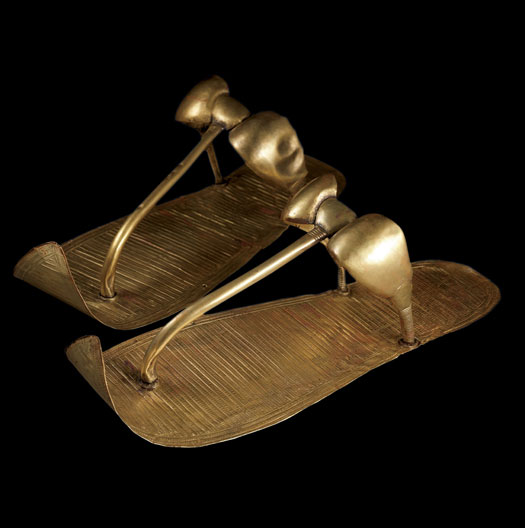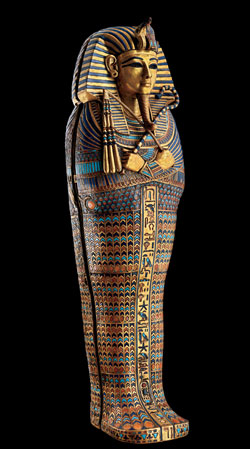
Tutankhamun's golden sandals © Sandro Vannini.
Our idea of preservation today is to look good while we're still here, sometimes by turning to cosmetic solutions, but that was not the case in the time of the Boy King, aka King Tutankhamun.
It is hard to fathom how artifacts from 1353 B.C. now on display at Denver Art Museum (DAM) could not only survive but look so good. Travel nearly 7,000 miles and more than 3,000 years back in time to explore the life, death and legacy of the Boy King at the DAM, the only city in the Rocky Mountain region to host the exhibition.
The relics on display now through Jan. 9, 2011 entitled "Tutankhamun: The Golden King and the Great Pharaohs" lasted because of the Ancient Egyptian practice of preservation, reinforced by religious beliefs. The Ancient Egyptians placed such extreme significance on the afterlife that they spent much of their time on the earth in preparation of it. Pharaohs were rulers of Egypt with divine powers because they were the liaison between the people and the Gods and they believed they needed to be physically prepared to meet their after-death destinies.
This is why the 100+ artifact show (50 pieces of which are objects from Tut's tomb) includes items like King Tut's golden sandals that he would wear into the afterlife and ornate funerary masks, like that of Psusennes, which was believed to aid in the deceased's divine transformation. Each organ, except the brain which was considered useless and the heart which was kept with the body, was preserved and contained separately in canopic vessles like the one that held Tut's mummified stomach. Whether or not the pharaohs were eternalized in the way they intended, there is no denying they accomplished their goal of immortalization through the majesty still surrounding them today. According to Executive Vice President for Mission Programs of National Geographic Society, Terry Garcia, "without exception, this is still the most popular subject of National Geographic covers," even though the first article on the topic was published more than 100 years ago.

Tut canopic coffinette © Sandro Vannini.
King Tut was the son of Akhenaten, a pharaoh considered a heretic because of his religious views, so many of the records of him and his successors were destroyed and little is known of his rule. The Boy King became pharaoh at age 9-10 and died mysteriously in the 9th year of his reign, so why is it that he is so touted today? It is not particularly his position as an Egyptian ruler for which he is renowned, it is his role in archaeological discovery. His tomb was unearthed by Howard Carter in November 1922 and is still studied today by expert archaeologists like Dr. Zahi Hawass, the secretary general of Egypt's Supreme Council of Antiquities and director of excavations at Giza, Saqqara and the Bahariya Oasis as well as his appointment as a National Geographic Explorer-in-Residence in 2001. As Garcia points out, "the 21st century is the greatest age of discovery of any human race because of technology," and thanks to these advances Hawass was able to lead a team in a CT-scan of the mummy of King Tut and other mummies to discover some of the mysteries surrounding the lives and deaths of other historical figures like Nefertiti and Hatshepsut."
Hawaas, who says he will never forget when he first met King Tut face to face, believes only about 30 percent of ancient Egypt's treasures have been excavated and he is extremely concerned with the future conservation and protection of Egypt's monuments. He has supervised a number of major preservation projects and developed site management plans for crucial sites. The Denver Art Museum is committed to antiquities preservation and conservation efforts in Egypt, including the construction of a new grand museum in Cairo, and will donate a portion of the proceeds to this future of discovery.
The exhibit will bring tourism, and most of all, culture to the Mile High City. Colorado has always played an integral role in arts and according to Denver's Mayor John Hickenlooper, this exhibit is a chance for all ages to, "get a real first-hand experience of what it was like when Tut reigned." And according to, Tony Bolazina, President of Northern Trust in Colorado, one of the exhibit's sponsors, it is important to education and a wonderful opportunity for children to get engaged in adventure. One of those children may be the one to discover the next King Tut.
"Tutmania" has overtaken Denver. The Brown Palace, the Sheraton Denver Downtown, the Curtis, the Hyatt Regency Denver, the Grand Hyatt Denver and the Westin Tabor Center offer various packages that include VIP tickets, transportation, activities for children, breakfast, parking and even a chance to win a trip to Egypt. But it's not only the hotels that are sharing in Denver's love affair with the Boy King. For adults, Wynkoop is brewing up a special batch of Tut's Gold microbrew and Peak's Lounge has a line-up of royal Tut-tinis as for children, Fun Egypt in the Duncan Pavilion at the DAM is the place to dress up like a queen or pharaoh for a day and engage in fun family playdates.
In the words of Hawaas, "We will always be fascinated with the secrets of the great pyramids, the silence of the sphinx and the mystery of the mummies."
Admission to "Tutankhamun: The Golden King and the Great Pharaohs" starts at $20 for members up to $30 weekends for nonmembers and includes access to every exhibit at the DAM.